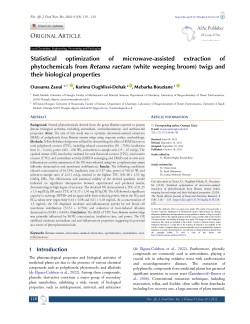Main Article Content
Statistical optimization of microwave-assisted extraction of phytochemicals from Retama raetam (white weeping broom) twigs and their biological properties
Abstract
Background: Several phytochemicals derived from the genus Retama reported to possess diverse biological activities, including antioxidant, anti-inflammatory, and antibacterial properties.
Aims: The aim of this study was to optimize microwave-assisted extraction (MAE) of polyphenols from Retama raetam twigs using response surface methodology.
Methods: A Box-Behnken design was utilized for determining the effect of MAE factors on total polyphenol content (TPC), including ethanol concentration (50 – 70%), irradiation time (4 – 6 min), power (400 – 600 W), and solvent-to-sample ratio (15 – 25 mL/g). The optimal extract (OE) was further analyzed for total flavonoid content (TFC), total tannin content (TTC), and antioxidant activity (DPPH• scavenging and FRAP) and in vitro anti-inflammatory activity assessment of the OE was evaluated using two complementary assays (albumin denaturation and membrane stabilization).
Results: The following conditions: ethanol concentration of 64.73%, irradiation time of 5.57 min, power of 569.16 W, and solvent-to-sample ratio of 22.91 mL/g, resulted in the highest TPC (181.48 ± 1.59 mg GAE/g DR). The effectiveness and statistical validity of the derived quadratic model indicated no significant discrepancies between experimental and predicted results, demonstrating its high degree of accuracy. The obtained OE demonstrated a TFC of 31.25 ± 1.5 mg EC/g DR and a TTC of 15.17 ± 1.56 mg EC/g DR. The OE showed a significant capacity to scavenge DPPH• and an appreciable ferric-reducing power, where the IC50 and EC50 values were respectively 0.44 ± 0.08 and 0.61 ± 0.03 mg/mL. At a concentration of 1.5 mg/mL, the OE displayed moderate anti-inflammatory activity by red blood cell membrane stabilization (72.72 ± 0.73%) and reduction of heat-induced albumin denaturation (50.89 ± 0.66%).
Conclusion: The MAE of TPC from Retama raetam twigs was primarily influenced by EtOH concentration, irradiation time, and power. The OE exhibited moderate antioxidant and anti-inflammatory properties, suggesting its potential as a source of phytopharmaceuticals.







